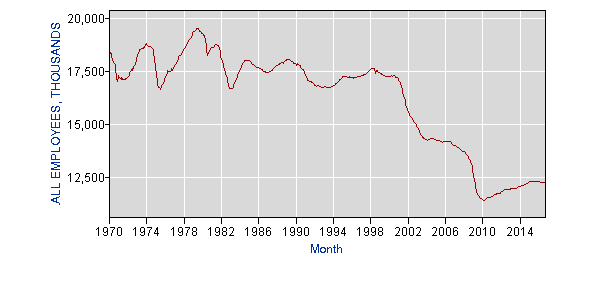March 01, 2017
It’s amazing how it is so acceptable in elite circles to tell outright lies to advance the trade agenda pursued by recent administrations. Everyone remembers when a 2007 Washington Post editorial touting NAFTA claimed that Mexico’s economy had quadrupled between 1987 to 2007. According to the I.M.F., the actual figure was 83 percent. The erroneous number can still be found online, since the Post lacks the integrity to correct it.
In this vein we find David Ignatius continuing the Post’s denialism, telling readers that workers in the Midwest are wrong to think that trade cost manufacturing jobs.
“Manufacturing employment has indeed declined in America over the past decade, but the major reason is automation, not trade. Robots, not foreign workers, are taking most of the disappearing American jobs. Rather than helping displaced blue-collar workers, Trump’s promises of restoring lost jobs could leave them unprepared for the much bigger wave of automation and job loss that’s ahead.
“The most persuasive numbers were gathered in 2015 by Michael J. Hicks and Srikant Devaraj at Ball State University. They showed that manufacturing has actually experienced something of a revival in the United States. Despite the Great Recession, manufacturing grew by 17.6 percent, or about 2.2 percent a year, from 2006 to 2013. That was only slightly slower than the overall economy.
“But even as manufacturing output was growing, jobs were shrinking. The decade from 2000 to 2010 saw “the largest decline in manufacturing employment in U.S. history,” the Ball State economists concluded. What killed those jobs? For the most part, it wasn’t trade, but productivity gains from automation. Over the decade, the report notes, productivity gains accounted for 87.8 percent of lost manufacturing jobs, while trade was responsible for just 13.4 percent.”
The basic story is that we have had automation for a century. Productivity growth has always meant that fewer manufacturing workers could produce the same amount of output. In the decades of the fifties and sixties, when productivity growth was far more rapid than it has been recent years, it was associated with rising wages and low unemployment. Productivity growth is not new and is usually good for workers.
What was new in the years from 2000 to 2007, when we lost over 3 million manufacturing jobs, was the explosion in the trade deficit.
Employment in Manufacturing

Source: Bureau of Labor Statistics.
While manufacturing employment was declining as a share of total employment over this whole period, there was little change in the number of manufacturing jobs until 2000. Employment then plummeted from 2000 to 2007 (before the crash) as a result of an exploding trade deficit. This deficit eventually peaked at almost 6.0 percent of GDP in 2005 and 2006, which would be more than $1.1 trillion in today’s economy.
David Ignatius would apparently like people to believe that if we produced another $1.1 trillion in manufactured goods to have had balanced trade, or just another $550 billion to keep our trade deficit around 3.0 percent of GDP, we wouldn’t need any additional workers. That might be a plausible story in Washington Postland, but not in the real world.
It is also worth noting that if Ignatius foresees a “much bigger wave of automation” ahead, then he is out of line with the Congressional Budget Office and other forecasters, all of whom see productivity growth remaining low for the indefinite future. His projection for a huge pick-up in productivity growth would put him line with the Trump administration’s rosy scenarios for future growth.
It is reprehensible that the proponents of the U.S. trade agenda feel they have to lie to push their case. When the elites tell outright lies like this and refuse to acknowledge obvious truths, it is not surprising that many people would look to racist demagogues like Donald Trump.







Comments